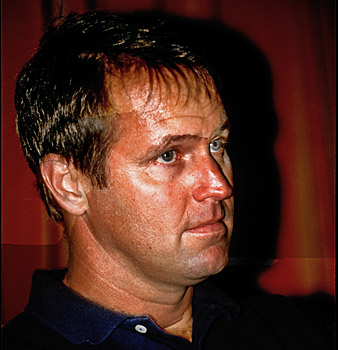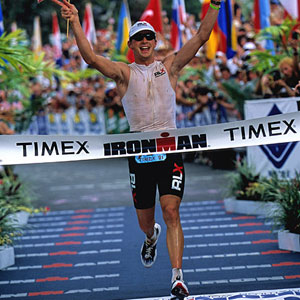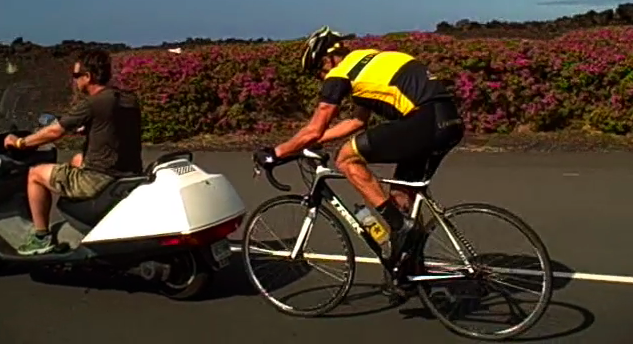Part Two: What CTS offers the triathlon world

Chris Carmichael on working with Peter Reid: Peter said I overtrained him and he burned out. When I worked with Peter he won Ironman Hawaii in 2000. He came to me and wanted to really focus on his cycling. He was also working with another triathlon coach and I was going to speak to that coach a few times on the phone but we never did. Peter made some significant gains in cycling and he won in 2000 and then thereafter I think he got pretty… I think ultimately he ended up doing just an awful lot without enough recovery time to adapt to the workload. I did not prescribe his run and swimming,. They came from another coach and this the whole program was not as well integrated as it should have been. It worked for a while and then it didn’t. Either way, it does not matter. I enjoyed my time working with Peter. Any time you win a championship like that there is success. But I was disappointed I was not able to have a continued relationship with him.
Tim DeBoom knew what happened with Reid, but feels confident working with the 2009 model CTS: I trust Peter a ton in that boat regarding his training with Carmichael. I think that was a learning experience for Peter and for Chris as well. When he was first starting, Chris may not have been quite used to working with triathletes.
Carmichael’s philosophy and approach: We have a very strong coaching recruitment and education program. We recruit people with the right qualifications to fit our system. Then we train them how we do things and stress real consistency and a good standard of delivery. We continue to use the latest technology available and that continues to evolve. We have been going to wind tunnels for 15 years. We have used power meters since 1993 when I was with USA Cycling, and which is something that continues to evolve greatly in the last five years. We use Training Peaks software to analyze power meter files in cycling, a great tool for analyzing power files. But its effectiveness really comes down to our coaches.
Carmichael starts with the athletes and hands off to individual coaches: Elite athletes are drawn to CTS and when they come, in I spent initially a fair amount of time with that athlete. I am also working with one of our coaches in tandem, and they eventually become the direct daily coach. When Craig first came to us, I was involved in the first year along with Nick White, and then in assisting Nick. In the second year, I had a lot less involvement and Nick took over while I provide analysis and review and some guidance. With Normann and with Tim, we follow the same process with their direct coaches, Leslie Hyman and Kirk Nordgren. I'm involved pretty much with both athletes programming and review and analysis as I work directly with one of our coaches. This year I'm more involved in programming and slowly I will be less involved in coaching with that athlete as a trust and bond grows between them.
Carmichael builds a sustainable, lasting brand – CC: The goal is to maximize the performance of each athlete. If all of our three elite Ironman athletes each do it, they will have a great race in Kona. I think that’s why I set up CTS in the first place. I can’t coach everybody. It’s a great sign that we have a lot of age group triathletes, cyclists, and runners. But we are also attracting a lot of elite athletes, who do not expect to be coached by Chris. They expect to be coached by our staff at CTS. Ultimately that is my sign that I am running this company the right way to build a sustainable lasting brand which does not just depend on one guy.
CTS essence is a pool of experts – CC: I think a lot of our strength is the pool of athletes we coach and the coaches that work together. You are not just getting one coach. You are able to draw from the knowledge base of our entire company. And that’s not only within the company, it’s within the reach and network of people we can turn to for guidance and advice and support.
Top sportsmen in different sports have this much in common – CC: So what does NASCAR guy have to do with an Ironman champion or a Tour de France winner have to do with Cyclocross champion medalist? And or mountain biking national champion? The truth of the matter is there are a lot of similarities at that elite level working athlete. They face a lot of similar pressures, anxieties, travel — all these things really are closely related. A strength we have a large roster of coaches and we will often talk and about that athlete in different ways we can approach their training and make improvements.
Knowledge gained from observing Lance – CC: Are we learning from how Lance is adapting to coming back at age 37? I'd say yes, it’s clear one of the ways we are seeing now as he competes through the Tour Down Under and the Tour of California is that Lance is in a new era. We notice, geez, he gets a couple days into the race and he seems to get tired whereas before he wasn’t. We note that it is still early in his comeback and that’s something we have to consider: What can we do for bettering recovery? The first thing for recovery, something that people tend not even consider is this — the fitter you are the quicker you recover from any effort. The more conditioned you are, the less it takes out of you.
Lactate threshold is the keenest measure of an athlete’s room to improve -CC: One of the most important things we look at when we bring in some of triathletes is power at lactate threshold. We find that there is fairly significant room for improvement. One of the things we have seen with some of the triathletes we work with is that they are not using a large percentage of VO2 max at lactate threshold. Lactate threshold is when the athlete crosses over from burning fat and carbohydrates as a fuel source to when you are burning almost all carbohydrates. If we can increase to a higher level of VO2 max power at lactate threshold use, you know they will generally have better performance on the bike and the run. I think things have gotten to such a state that elite athletes are getting out of the water at the same or close to the same amount of time. They are grouped pretty tightly and packed up so triathletes get on the bike within a narrow range and so don’t lose a lot of time on the swim. So with the swim, you want to hit the sweet spot where you stay in range and do not waste a lot of energy and make sure to start the bike with the leaders and do not lose a lot of energy catching up to the main pack. So we want to improve efficiency on the bike to have a great run.
It's not ALL about the bike, but that is where to look – CC: I can’t say we know the race is won on the run since Normann Stadler proved it can be won on the bike. But we must take into consideration that the greatest portion of the Ironman by far is the of any of triathlon's three sports is the cycling leg. Whether it is 4 hrs 18 minutes on the bike as Normann did in 2006 or something more conservative, it is still the greatest amount of time spent of all the sports. So you need to maximize your energy as efficiently and you can to get off and capitalize on your run — or be able to capitalize on bike as best you can and be able to run conservatively to be able to win.
You have to be able to measure and know why you had a bad day. No guessing – CC: Back in 2004, Peter Reid and Tim DeBoom trailed Normann by 20 minutes at T2. Even now, they do now know why. The thing we try to do is not leave lot of things to question where you don’t know why you had a bad day. We want to quantify it. Fine, everyone has some a bad days. But why do you have a bad day? We try to back it up with much data to support a diagnosis when we look at a power file that shows how the athlete was running when they started have cramps. What were the split times? We need to quantify. Early in the season, we would like compete with a bike power meter even if they don't look at it. I don't think there is a lot to be gained by using a heart rate monitor for the run. I'm more looking at one thing that is the best guide for performance – and the use of a power meter for the bike is very helpful. It would be difficult to use it in Kona. But Tim will compete in Ironman Australia in April and we’d really like to see it there.
There are reasons not to us them in a race. An SRM weighs a little more. It is a little distracting. From an actual racing standpoint, he will have a pretty good idea about his power and how it can be used for pacing. Tim is already starting to get that all-out bike training intensity, and he understands power is a useful tool for prescribing pacing.
Details of power readout analysis – CC: Over the course of a whole ride, you take out downhill sections, those periods where the rider is not pedaling and look at that in relationship to what has been prescribed in the past in training by comparing that ride to periods of time when Tim is at his best power output. Then you determine in a workout if Tim is able to hold a certain power output for 15 minutes or for 30 minutes and for certain periods of time and look at the e-profile of what he produces in a race, for example.
How power readouts worked with Lance – CC: I will give you an example what we look at with Lance. In the Tour of California he did a time trial of 25 kilometers in roughly 30 minutes. I think he did 31:53. That was the highest 30 minutes of power he produced during his entire comeback. We know that he did better than before, but he finished 14th OK so we were a little disappointed. We felt that he should have had a higher placing. So we tried to break it down by noting where there were corners on the stage and see if he was maybe accelerating too high coming out of corners and spiked the power. Or in some areas aerodynamics played a bigger role in good power producing dynamics. And had he had a better position he might have had a better race.
The things we look for and similarly look for in triathlons – CC: What is the power output for how much time? We are looking at cadence, at the power levels we what look at what we prescribe in training to achieve a pretty sustainable level. And you also get a good idea that if you do 20 minute efforts at this power output you know you are having a good day. If this power starts to fade away at 8-10 minutes, then you know it is not a good day.
Triathletes are CTS’s fastest growing category -CC: Triathletes are our fastest growing category. That is great. I think with Craig the success last year obviously that was good for the company. Our company has some founding pillars on which the company is founded. One of the ways we judge our success is the performance of elite athletes.
They are our best research and development.
CTS does not pay their four elite triathletes – CC: Triathletes think we are paying them. We have a founding principle that we will always coach elite pro level athletes. We believe it starts there and rolls down. So Tim DeBoom, Normann Stadler, Simon Whitfield work with us. In return for coaching and access to our resources, we can use their name and image and ask to be available for interviews. If they feel this is not working,. It’s no problem. They can leave.
Risk is involved – CC: Offering our coaching resources is not like offering a pair of shoes. Coaching is a very personal form of communication. If things are not working, just tell us and we will just shake hands and wish you the very best and go your own way. There are no contracts, but this is a serious investment for us. We take our best coaches and if they do not do a good job with the athletes, their performance can reflect very poorly on us, too. We take the best coaches, bring 'em to wind tunnels, and spend a lot of hours in analysis. Instead of saying here is a monthly fee, when we take one of these guys on we think about it hard about whether we are willing to do this. It is an expense. We are excited and need to do it. But we also know we have to do a good job. It is a risk if they do not perform under our guidance.



